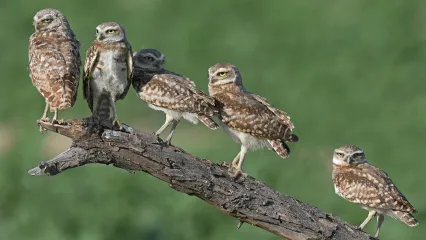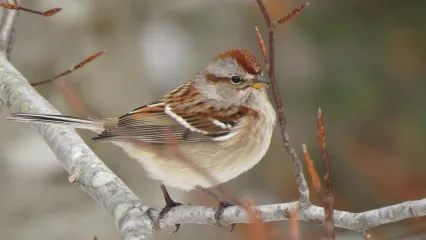
Description
If there was ever a bird with a large-scale identity crisis it would have to be the burrowing owl (Atnene cunicularia). It is a predatory bird just like every other raptor. but it resides in holes dug primarily by prairie dogs and mimics the rattling sound of a rattlesnake.
Found in the western third of the state, but most commonly in the panhandle, the burrowing owl is one of the state's most unique avian species Classified as a "grassland specialist," the burrowing owl can be found in shortgrass prairie or desert habitat. The burrowing owl will excavate its own hole, but only in extreme cases. It relies primarily on vacant holes dug by mammals, such as the black-tailed prairie dogs.
The burrowing owl is also one of the most identifiable owl species found in Oklahoma. Along with its white eyebrows, brilliant yellow eyes. and lack of ear tufts, the burrowing owl almost appears to be standing on stilts. Its long legs are unique among other owl species and are adapted for its ground-dwelling lifestyle.
Another unique characteristic of the burrowing owl is its feeding habit. While most owl species are nocturnal feeders. the burrowing owl is crepuscular, feeding at dusk and dawn. It can also be observed eating during the daytime, something you would rarely see from other owl species They are opportunistic feeders, primarily on insects, small mammals, and birds, but won't hesitate to snatch up any small reptiles or amphibians.
The burrowing owl has one predatory defense that makes it one of the most interesting birds we have here in Oklahoma. To deter approaching predators, the burrowing owl utters a call that mimics the rattling sound of a rattlesnake within the burrow, causing wary predators to keep their distance from its burrow.
The burrowing owl is listed as a species of concern in Oklahoma and is even classified as threatened in many other states. Due to the loss of habitat from urbanization and fragmentation, burrowing owl populations have been decreasing. With the preservation of native grasslands and protection of burrowing mammals, we can retain this unique species for the viewing by future generations.
Size
The burrowing owl, a medium-size bird grows to about nine inches tall.
Habitat
The burrow or nest of the burrowing owl is typically six to nine feet in length and descends three to five feet before ending with a large "domed" chamber. The nest is typically lined with dried manure. possibly to absorb water to reduce flooding within the nest, but may also serve to hide the scent of the owl.
The problem with being a ground-dwelling bird is the increased threat of predation. While most birds avoid predation by nesting in trees, the burrowing owl has to deal with numerous threats. Nesting in areas of short vegetation helps the burrowing owl to see possible ground predators that are approaching the nest. Keeping the nest away from trees and tall structures helps the burrowing owl avoid being prey to a larger bird that could be perching outside the nest. Some of the main predators of the burrowing owl are larger raptors, snakes, coyotes, bobcats, and domestic cats.
Life Cycle
Breeding occurs from mid-March through September. The average clutch size is six eggs and incubation lasts for 28-30 days. The female will generally stay with the nest during incubation, while the male guards the nest and collects food. Three to four weeks after hatching, the family will switch burrows every 10-15 days. This moving of nests shows the importance of prairie dogs for burrowing owls, since they dig numerous holes. Six weeks after hatching, the young are capable of flight. The young feed primarily on insects and begin working on their predatory skills by jumping on dead or live insects.


